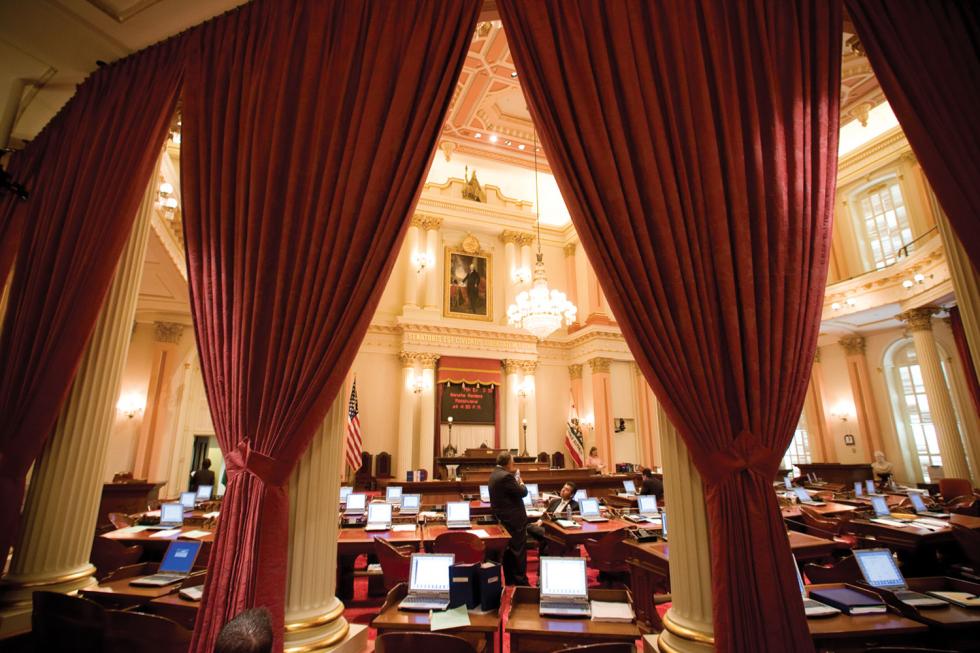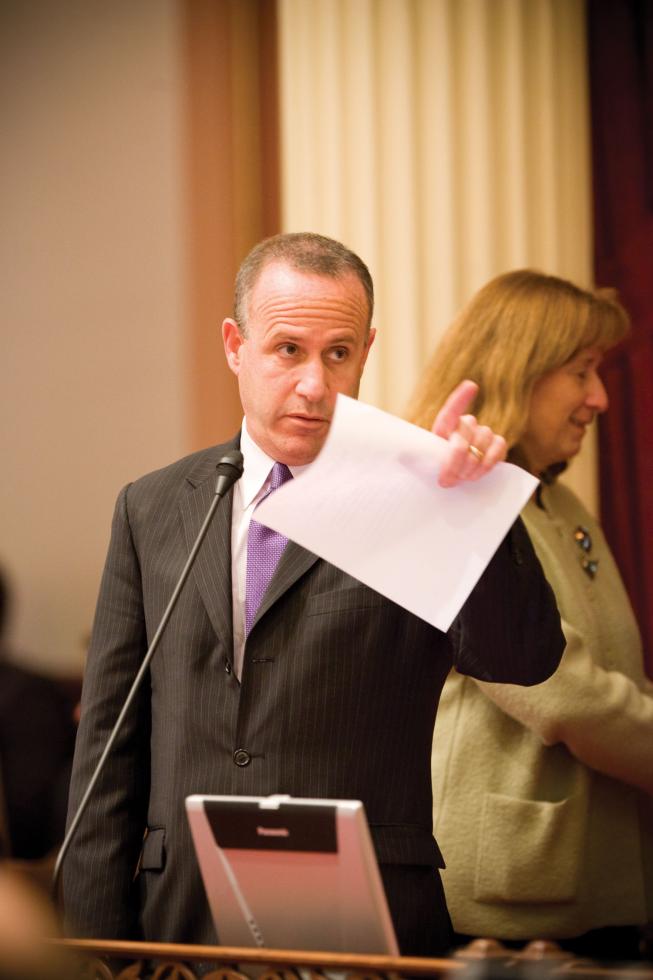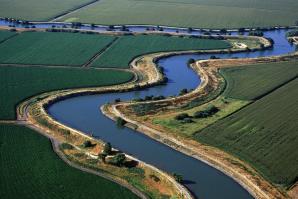The San Joaquin River at the Mossdale County Park near Manteca.

This is the final story in a four-part series on water. This month, we’ll wrap up by examining upcoming issues in 2010. Past installments of this series have explored water issues ranging from storage, conservation and desalination, to impacts of a peripheral canal on the Sacramento-San Joaquin Delta.
Mark Twain once said that, in the West, “Whiskey is for drinking. Water is for fighting over.” For decades, California has been the living embodiment of Twain’s observation. Now, after two-plus years of contentious posturing and political bloodletting, California lawmakers have finally agreed on a multibillion-dollar plan to overhaul the state’s outdated water system. But while reformers have claimed victory in the biggest water battle to date, the real war — convincing voters to pay for it — is just getting started.
This won’t be an easy sale. Deep-seeded regional rivalries and powerful philosophical differences have always enveloped the state’s water policies. As Valerie Nera, a water policy advocate for the California Chamber of Commerce, notes, “Everybody thinks their priorities are more important than everyone else’s.” In spite of the bipartisan support, the $11.1 billion overhaul package from lawmakers in November does little to abate that perspective.
Perhaps this isn’t surprising, given the disparate agendas that various players brought to the game. Republicans wanted more dams. Democrats and many powerful environmental groups preferred statewide conservation efforts. Equally powerful Central Valley farm operations wanted to slake the thirst of the water-intensive crops they have long grown in otherwise-arid ground. They insisted on a “new conveyance” around the Delta — known as a peripheral canal — to make it happen.
Southern California and Bay Area officials also noted their own human and commercial thirsts, while developers statewide called for a reliable, legally mandated water supply for future projects.
Sacramento-San Joaquin Delta residents and coastal fishermen, meanwhile, vowed to fight any attempt to build the peripheral canal, saying it would further damage one of the nation’s most endangered estuaries, sending that ecosystem — and perhaps their way of life — into a death spiral. The Sacramento Regional County Sanitation District also waded into the canal debate, arguing that new upstream diversions for that project could force them to spend millions of dollars on equipment upgrades. Those costs, unless borne by end-users who benefit most from the canal, would end up falling on Sacramento ratepayers. Sacramento and other Northern California cities likewise lined up against mass conservation mandates they say would drive up rates for local water users and jeopardize the region’s long-held area-of-origin water rights.
The list of stakeholders seemed endless at times, producing a steady stream of self-interested rhetoric that billowed from California to Washington. With mounting pressure, it’s easy to see why Gov. Arnold Schwarzenegger called water reform “one of the most complicated issues in our state’s history.”
What ultimately came out of the legislative sausage grinder is both encouraging and maddening. In many ways, the historic deal, brokered primarily by Senate President Pro Tem Darrell Steinberg, achieved the “co-equal goals” of ensuring greater water reliability for downstate users and stronger environmental protections for the Delta.
California will collect data on groundwater reserves for the first time in state history. However, it won’t track how much is taken from the system and by whom, which the agriculture industry fiercely opposed. The measures also codify Schwarzenegger’s 2008 executive order for a 20 percent cut in statewide urban water use by 2020. But no such mandate will be applied to agricultural users, though they consume roughly four times more water annually than urban users.
“Urban conservation is miniscule next to ag use,” says Stockton-area developer Fritz Grupe, who is also a member of the California Partnership for the San Joaquin Valley, a public-private partnership to boost the Central Valley economy. “Why piss off homeowners? We should go after big users and not fool around with small guys.”
Farmers also got a break on a proposed crackdown on illegal water diversions, which, according to Schwarzenegger’s Delta Vision Blue Ribbon Task Force, account for up to two-thirds of water drained from the Delta. Although the original proposal called for hitting illegal diverters with daily fines equal to the market cost of the water they steal, agricultural opposition caused it to drop from the final bill. Lawmakers instead settled on giving the State Water Resources Control Board 25 additional employees to help go after illegal diverters.
The overhaul includes new environmental protections and oversight for the troubled Delta, including water quality projects and wide-ranging habitat restoration. It also offers millions of dollars to mitigate the fiscal impact those efforts may have on the Delta economy. While canal advocates didn’t get specific authority to build a new conveyance, Steinberg did gain approval for a new Delta oversight agency. The Delta Stewardship Council is expected to rein in some of the more than 200 local agencies that currently have a hand in managing the Delta.
A handful of legislators stayed on the Senate floor while
Democrats caucused before passing the water bill.

But the Stewardship Council has also earned Steinberg the ire of Delta residents, who note that only one of its seven members — four of whom would be appointed by Schwarzenegger — would be from the Delta region. Sen. Lois Wolk, a fellow Democrat who represents multiple Delta counties, accused Steinberg of “throwing the Delta under the bus.”
In theory, the Stewardship Council could sign off on building the peripheral canal, something Schwarzenegger made clear he thinks is already a done deal. The governor repeatedly told a packed news conference the day after the bill’s approval, “This will build the canal in order to protect the Delta.” He repeated the assertion days later in Stockton, where he signed one of the bills into law.
That seemed to be news to Steinberg, who says that numerous environmental conditions must be met before any agency could authorize a canal. He also acknowledged that Schwarzenegger is pushing hard to ensure the Bay Delta Conservation Plan, which includes the canal, is completed before the governor leaves office. Steinberg defends the council as the best way to ensure the Delta’s health gets top billing, regardless of whether or not the peripheral canal is built.
“The Stewardship Council has the ability to say no,” he says. “If you are an opponent of a new conveyance, the council offers you a new layer of ‘check’ that isn’t available to you today.”
“Why piss off homeowners? We should go after big users and not fool around with small guys.” Fritz Grupe, founder, The Grupe Co.
That possibility is not soothing to opponents. Although the major water agencies who would benefit the most from it — the Central Valley’s Westlands Water District and Southern California’s Metropolitan Water District — would have to contractually agree to pay for building the project, estimated at $6 billion to $12 billion, any attempt to actually do so will meet fierce opposition. When Department of Water Resources chief Lester Snow said publicly in October that the state has the authority to build the canal without legislative approval, Wolk and fellow Democratic Assemblywoman Alyson Huber, who represents El Dorado Hills, introduced legislation that would bar the state from doing so without specific approval from the Legislature. Litigation is also expected to stifle any attempt at breaking ground for a canal.
The bond measure also drew howls of protest from critics who argue it contains billions of dollars of unnecessary spending, most of it used to coerce reluctant lawmakers to vote for the measure. The flurry of special inserts included such perks as $50 million for the state university system to fund “agricultural water research,” $30 million to state parks for “watershed education” and $10 million to the Natural Resources Agency for watershed protections that address climate change. The total package ultimately ballooned from its original $9 billion to a final tally of $11.14 billion.
All of which begs the question: what now?
The answer is already playing out. For one, the federal government has worked its way into the mix. Interior secretary Ken Salazar has taken a particular interest in California’s water issues, earmarking hundreds of millions of dollars in federal grants for state water infrastructure. He also has named his undersecretary, David Hayes, to serve as a “water czar” to oversee the federal government’s efforts in California.
Some of California’s congressional contingent, including Rep. Bill McClintock, a Republican, and Sen. Dianne Feinstein, a Democrat, is pushing for even greater federal involvement. Both have joined Schwarzenegger in calling for a new look at the science used to justify court-ordered water pumping restrictions to protect endangered Delta smelt. Critics have complained bitterly that the smelt decisions are the result of singling out one species and one stressor to the detriment of the bigger picture.
Even more federal intervention should be expected, although Salazar’s office has so far been noncommittal to Feinstein’s proposal. And while water warriors from Congress to the fallowed fields of the Central Valley continue to seek changes to the Endangered Species Act that led to the smelt order, most observers doubt that will happen.
“As bulky and clunky as the ESA is, it is necessary,” says Jason Morrison, a program director with the Oakland-based Pacific Institute, a nonpartisan group that researches global water issues.
Senate Pro Tem Darrell Steinberg

State and federal officials are also considering other ways to address the Delta smelt issue, including a program known as the Two-Gates Fish Protection Demonstration Project. That plan would install two temporary, removable gates in specific Delta channels as a way to prevent smelt from being swept into the pumps that drive water southward. The Bureau of Reclamation is planning a five-year study to test the project, and the state’s bond proposal includes $28 million to help fund the effort.
Whether voters endorse the bond package next November remains to be seen. State finance officials reported last month that lawmakers will return to work in 2010 already facing a budget deficit around $7 billion for fiscal year 2009-2010, with another $10 billion to $14 billion shortfall expected for fiscal year 2010-2011. If approved by voters, the bond package would saddle the state with an additional $809 million annually in debt service. Without a major boost to the sagging economy, skeptical voters may not be inclined to push the state deeper into debt.
The measure is also likely to bring together an odd pairing of traditional rivals. State employee unions may fight the bond measure, arguing that the increased debt service on the budget will leave the state with less money for state salaries and programs. Tax groups, normally not in sync with union desires, also oppose the increased debt service the bonds will bring.
The governor’s lobbying has also heightened the suspicions of Northern California residents who believe Schwarzenegger, a longtime Southern Californian, doesn’t really care what they want. Dr. Peter Gleick, president of the Pacific Institute, believes the governor’s intense lobbying on behalf of big Central Valley agribusiness throughout the year has inflamed tensions and eroded trust between stakeholders. The governor spent much of 2009 pounding home big agriculture’s mantra that the water situation is one of “fish vs. farmers,” a view that, outside the Central Valley, many hold as an oversimplification of the smelt debate.
“Unfortunately, most of this has just been about politics,” says Gleick, who calls the “fish vs. farmers” argument an “almost criminal” distortion of the issue.
David Okita, general manager for the Solano County Water Agency, says his agency hasn’t taken an official position on a canal but agrees that all the hyperbole has taken its toll. “Distrust between the players is by far the biggest impediment to reform,” he says.
And what happens to the reform package if that distrust leads voters to turn down the bond measure?
In policy terms, says Delta Vision co-chair Phil Isenberg, not much. “With or without the bond money, these reforms adopt policies that move California toward making water supply and environmental stability co-equal goals,” he says.
If the bond fails, Isenberg says, the state will still be able to fund some elements, such as some of the conservation programs, within the current budget. Other reforms, he says, will likely see dollars from a variety of state, federal and local sources in much the same way transportation is funded.
“The important thing is that this package ends the argument over whether the environment is worth protecting,” he says. “It is.”
Tim Quinn, executive director of the Association of California Water Agencies, says the best way to avoid searching for alternate funding mechanisms is to make sure the bond passes. That means, he says, advocates will have to immerse themselves in “educating California residents” about what is at stake. Quinn acknowledges it could be a Herculean task.
“The bond has a really rough road ahead,” says Quinn, a strong advocate for the reform package. “We’re going to be debating what co-equal goals means for years.”
John Woodling, executive director of the Sacramento-based Regional Water Authority, is also gearing up for educating consumers, though not in the same manner as Quinn. Like many Northern California water agency officials, Woodling is very concerned over the state’s new water direction, particularly in how it could eventually impact his ratepayers.
“We will need to educate our customers,” he says. “We must be diligent to ensure that the potential threats in all of this don’t become real.”
Woodling also cautions that the process has really only just begun.
“We’re not even at the 10 or 15 percent point yet,” he says. “We’re really just at a whole new beginning.”
Recommended For You

Changing Tide
Turf and money battles continue over California water reform
It’s been about 20 months since lawmakers and former Gov. Arnold Schwarzenegger breathlessly announced a historic agreement called the Sacramento-San Joaquin Delta Reform Act of 2009, an ambitious plan to overhaul the state’s antiquated water system. Much has changed since then, but much more is still on the way.

Of Rice and Men
On the Cover: Parched by years of drought, thousands of California’s rice fields lie barren
In the Sacramento Valley, where 97 percent of the state’s rice crop is grown, family farmers have been forced to fallow cropland they have worked for generations. The economic hit has been hard and true, affecting not just farmers, but seed distributors, equipment dealers and anyone else with a thumb in the rice business. The drought could cost Central Valley farmers and communities $1.7 billion this year and may lead to more than 14,500 layoffs.


